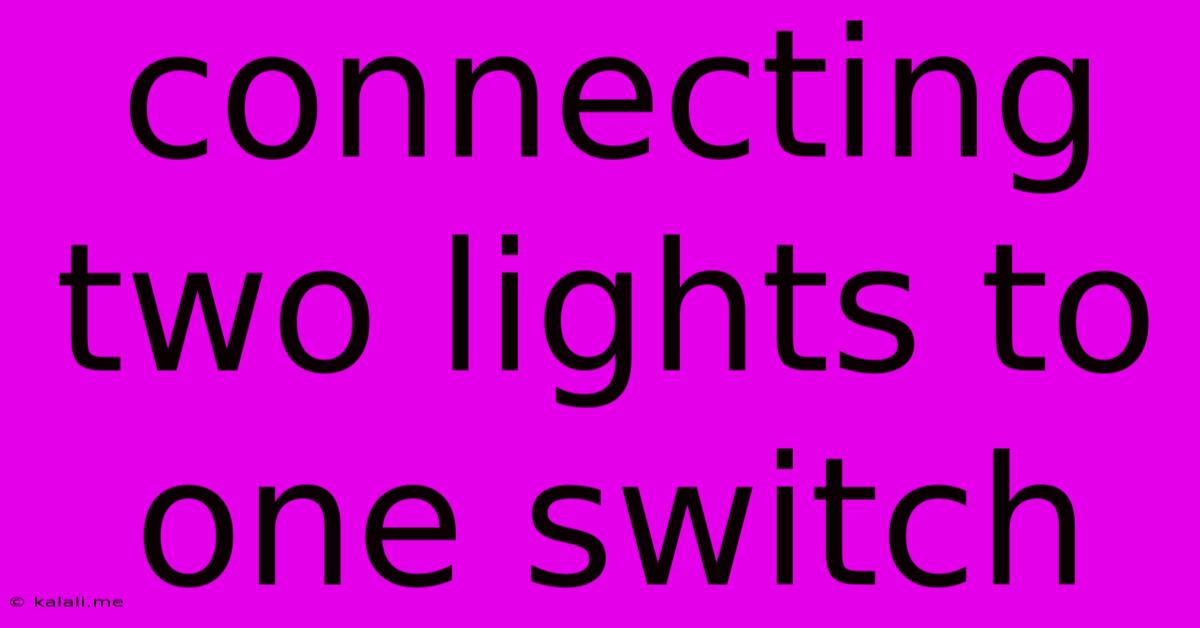Connecting Two Lights To One Switch
Kalali
May 20, 2025 · 4 min read

Table of Contents
Connecting Two Lights to One Switch: A Comprehensive Guide
Meta Description: Learn how to safely and effectively wire two lights to a single switch, covering different wiring configurations and essential safety precautions. This guide provides clear instructions for both beginners and experienced DIYers.
Wiring two lights to a single switch is a common home improvement project that can significantly enhance your home's lighting. This seemingly simple task requires careful attention to detail and adherence to safety regulations to avoid electrical hazards. This comprehensive guide will walk you through the process, covering various scenarios and providing crucial safety tips. Whether you're a seasoned DIY enthusiast or a complete beginner, this guide will empower you to tackle this project with confidence.
Understanding the Basics: Parallel Wiring
The most common and efficient method for connecting two lights to one switch is using parallel wiring. This means that both lights are connected independently to the switch, creating two separate circuits that operate simultaneously. This setup ensures that if one light malfunctions, the other will continue to function normally. This contrasts with a series circuit, where a failure in one component would cause the entire circuit to fail. Therefore, we'll focus exclusively on the safer and more practical parallel wiring configuration.
Essential Tools and Materials
Before you begin, gather the necessary tools and materials. This will ensure a smooth and efficient workflow. You will need:
- Wire strippers/cutters: To safely strip the insulation from the wires.
- Screwdrivers: Phillips and flathead screwdrivers of appropriate sizes for your switch and light fixtures.
- Electrical tape: To insulate wire connections securely.
- Wire connectors (wire nuts): To securely join wires together. Choose the correct size for the number of wires you're connecting.
- Voltage tester: To confirm the power is off before starting any work. This is crucial for safety.
- Two light fixtures: Ensure they are compatible with your wiring and voltage.
- Electrical switch: Single-pole switches are commonly used for this purpose.
- Electrical wiring: Sufficient length to connect all components.
Step-by-Step Wiring Instructions
1. Turn Off the Power: This is the most critical step. Locate the circuit breaker controlling the lights and switch and turn it completely OFF. Use the voltage tester to double-check that the power is indeed off at the switch and light fixture locations.
2. Connect the Lights: Wire each light fixture according to its individual instructions. Typically, this involves connecting the black (hot) wire to the black wire from the switch, the white (neutral) wire to the white wire from the switch, and the ground wire (usually bare copper or green) to the fixture's ground terminal.
3. Wire the Switch: At the switch location, connect the incoming hot wire (usually black) to the switch's common terminal (usually marked "COM" or with a similar designation). Connect the two outgoing hot wires (one for each light) to the remaining switch terminals (often labeled "Line" and "Load" but can vary). Connect the neutral (white) wires together using a wire nut. Connect the ground wires (bare copper or green) together using a separate wire nut.
4. Secure Connections: Ensure all wire nuts are tightly secured to prevent loose connections, which can lead to overheating and fire hazards. Wrap the connections with electrical tape for extra insulation.
5. Mount the Fixtures and Switch: Carefully mount the light fixtures and the switch in their designated locations.
6. Turn on the Power: After completing all connections, carefully restore power to the circuit by switching the breaker back ON.
7. Test the Lights: Turn the switch ON and OFF to verify that both lights are functioning correctly.
Troubleshooting
If one or both lights fail to function, carefully check the following:
- Power: Confirm the power is on at the breaker.
- Wire Connections: Examine all wire connections for tightness and proper insulation.
- Loose Wires: Look for any loose wires inside the light fixtures or switch box.
- Faulty Bulbs: Replace the bulbs with new ones to rule out a simple bulb failure.
- Faulty Switch or Fixture: In some cases, a defective switch or light fixture may be the cause.
This guide provides a comprehensive overview of connecting two lights to one switch. Remember to prioritize safety throughout the process and always double-check your work before restoring power. If you're uncomfortable performing electrical work, consult a qualified electrician. This project can be a rewarding DIY experience when approached with caution and the right knowledge.
Latest Posts
Latest Posts
-
How Do You Get Hair Dye Off The Wall
May 20, 2025
-
Do Plug Socket Wires Run Up Or Down Uk
May 20, 2025
-
How To Patch A Small Hole In Plaster Ceiling
May 20, 2025
-
How Long Will Fish Live Without A Filter
May 20, 2025
-
Honeywell Thermostat Wiring Diagram 3 Wire
May 20, 2025
Related Post
Thank you for visiting our website which covers about Connecting Two Lights To One Switch . We hope the information provided has been useful to you. Feel free to contact us if you have any questions or need further assistance. See you next time and don't miss to bookmark.